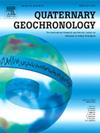Developing a new approach to the luminescence dating of sediments from glacial contexts
IF 1.7
2区 地球科学
Q3 GEOGRAPHY, PHYSICAL
引用次数: 0
Abstract
Whether glacial sediments were exposed to light (bleached) prior to burial is uncertain but critical for luminescence dating. In such contexts, quartz can have unstable and weak signals, feldspar have less bleachable and fading signals and both require statistical modelling to extract the true burial age data. This paper presents a new approach using feldspars measured at multiple elevated temperatures (MET) and screened to select grains with plateau equivalent dose values which should be the well-bleached and unfaded grains upon which to base a true burial age. The MET plateau approach was tested on an aeolian site in Canada and two former UK glacial sites. When applied to the Canadian aeolian samples, it showed that the method successfully accepted mostly well-bleached grains whilst excluding grains with fading or that had poor luminescence characteristics. When applied to a well dated glacial sequence it yielded ages in good agreement with existing independent chronologies. A previously undated glacial site yielded stratigraphically consistent ages but these are thought likely to be slight age over-estimates due to extremely limited bleaching at deposition. In summary, the MET plateau approach improved avoidance of partially bleached grains, avoided corrections for residuals and/or fading and reduced the need for statistical models to interpret equivalent dose distributions. However, some glacial sediments may have had so limited bleaching that these may still not be easy to luminescence date. The MET plateau approach if adopted could allow re-evaluation of existing glacial chronologies and extend luminescence dating to more glacial sediments.

建立了一种新的冰川沉积物发光测年方法
冰川沉积物在埋藏之前是否暴露于光下(漂白)是不确定的,但对于发光测年至关重要。在这种情况下,石英可能具有不稳定和微弱的信号,长石具有较少的可漂白和衰落信号,并且都需要统计建模来提取真实的埋藏年龄数据。本文提出了一种新的方法,利用长石在多次高温(MET)下的测量和筛选来选择具有平台等效剂量值的颗粒,这些颗粒应该是充分漂白和未褪色的颗粒,以此为基础来确定真正的埋藏年龄。MET高原方法在加拿大的一个风成地点和两个前英国冰川地点进行了测试。当应用于加拿大风成样品时,表明该方法成功地接受了大部分漂白良好的颗粒,而排除了褪色或发光特性较差的颗粒。当应用于年代确定的冰川层序时,它得出的年龄与现有的独立年代学很吻合。一个先前未确定年代的冰川遗址产生了地层上一致的年龄,但这些年龄被认为可能是轻微的高估,因为沉积时的漂白非常有限。总之,MET平台方法改进了对部分漂白颗粒的避免,避免了对残差和/或衰落的修正,减少了对统计模型解释等效剂量分布的需要。然而,一些冰川沉积物可能漂白程度有限,因此可能仍不容易进行发光日期测定。如果采用MET高原方法,可以重新评估现有的冰川年代学,并将发光测年扩展到更多的冰川沉积物。
本文章由计算机程序翻译,如有差异,请以英文原文为准。
求助全文
约1分钟内获得全文
求助全文
来源期刊

Quaternary Geochronology
地学-地球化学与地球物理
CiteScore
4.40
自引率
22.20%
发文量
130
审稿时长
20 weeks
期刊介绍:
Quaternary Geochronology is an international journal devoted to the publication of the highest-quality, peer-reviewed articles on all aspects of dating methods applicable to the Quaternary Period - the last 2.6 million years of Earth history. Reliable ages are fundamental to place changes in climates, landscapes, flora and fauna - including the evolution and ecological impact of humans - in their correct temporal sequence, and to understand the tempo and mode of geological and biological processes.
 求助内容:
求助内容: 应助结果提醒方式:
应助结果提醒方式:


